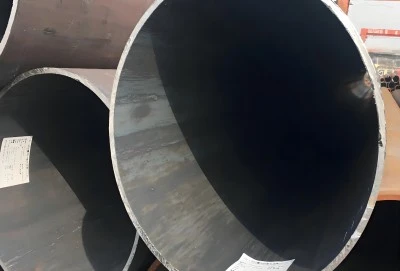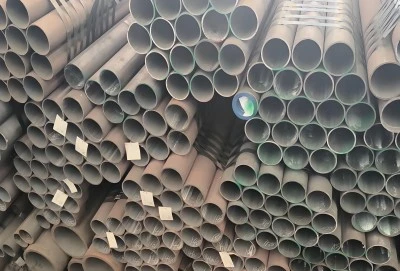S275JR steel pipe is a popular structural steel grade known for its excellent balance of strength, weldability, and cost-effectiveness. The chemical composition and mechanical properties of S275JR pipes make them suitable for various applications in construction, oil and gas, and industrial sectors. This article delves into the specific chemical and mechanical specifications of S275JR pipes, providing valuable insights for engineers, project managers, and procurement specialists working on large-scale projects worldwide.
|
|
|
Chemical Composition of S275JR Steel Explained
The chemical composition of S275JR steel plays a crucial role in determining its performance characteristics. Understanding these elements and their proportions is essential for engineers and project managers to make informed decisions about material selection for their projects.
Carbon content: Key to S275JR's weldability
Carbon is a fundamental element in S275JR steel, significantly influencing its weldability and strength. The carbon content in S275JR steel typically ranges from 0.18% to 0.22%. This relatively low carbon content contributes to the steel's excellent weldability, making it a preferred choice for structural applications that require extensive welding.
The moderate carbon levels also ensure that the steel maintains good ductility, allowing it to withstand various stresses without becoming brittle. This balance between strength and weldability is particularly valuable in projects involving complex structural designs or those requiring on-site fabrication.
Manganese's role in S275JR strength and ductility
Manganese is another critical element in S275JR steel, typically present in concentrations between 0.50% and 1.60%. This element serves multiple purposes in the steel's composition. Primarily, manganese acts as a deoxidizer, removing excess oxygen from the molten steel during production. This process helps prevent the formation of harmful oxides that could compromise the steel's integrity.
Moreover, manganese contributes to the steel's overall strength and hardness without significantly reducing its ductility. This property is particularly beneficial in applications where the material needs to withstand both static and dynamic loads, such as in bridge construction or offshore platforms.
Silicon, phosphorus, and sulfur in S275JR steel
Silicon, phosphorus, and sulfur are present in smaller quantities but play important roles in S275JR steel's properties. Silicon, typically ranging from 0.10% to 0.40%, acts as a deoxidizer and contributes to the steel's strength. Phosphorus and sulfur are usually limited to maximum levels of 0.035% and 0.035%, respectively. These elements are carefully controlled to minimize their potential negative effects on the steel's properties, such as reduced ductility or weldability.
The precise balance of these elements ensures that S275JR steel maintains its desired characteristics, making it suitable for a wide range of applications in the construction and industrial sectors. Understanding these chemical specifications is crucial for engineers and project managers when selecting materials for specific project requirements.
Mechanical Properties: Tensile Strength and Yield Point
The mechanical properties of S275JR steel pipes are crucial factors in determining their suitability for various applications. These properties define how the material behaves under different types of stress and loading conditions, making them essential considerations for engineers and project managers in the selection process.
S275JR tensile strength: 430-580 N/mm² range
The tensile strength of S275JR steel pipes typically falls within the range of 430-580 N/mm² (or MPa). This property indicates the maximum stress that the material can withstand before failing under tension. The relatively high tensile strength of S275JR makes it suitable for applications where the material needs to resist significant pulling forces.
For instance, in bridge construction or high-rise buildings, where structural elements are subject to considerable tensile loads, S275JR steel pipes can provide the necessary strength to ensure structural integrity. The upper limit of 580 N/mm² allows for a safety margin in design calculations, accommodating potential variations in material properties or unexpected load increases.
Minimum yield strength of 275 MPa in S275JR
The yield strength of S275JR steel is a minimum of 275 MPa, as indicated by the '275' in its designation. This property represents the stress at which the material begins to deform plastically. In practical terms, it's the point at which the steel starts to permanently change shape under load.
The 275 MPa yield strength is particularly important in structural design. It allows engineers to calculate the maximum load that a component can safely bear without permanent deformation. This characteristic makes S275JR steel pipes an excellent choice for applications in oil and gas pipelines, where maintaining structural integrity under high pressures is critical.
Impact resistance and machinability of S275JR
S275JR steel also exhibits good impact resistance, especially at room temperature. This property is crucial for applications where the material might be subject to sudden loads or impacts, such as in industrial machinery or transportation infrastructure. The 'JR' in the designation indicates that the steel has been tested for impact resistance at 20°C, ensuring its suitability for use in moderate climates.
Regarding machinability, S275JR steel offers a good balance between hardness and workability. While not as easily machinable as some lower-strength steels, it can still be cut, drilled, and welded with standard tools and techniques. This characteristic is particularly valuable in fabrication processes, allowing for efficient production of complex structural components.
The combination of these mechanical properties - tensile strength, yield strength, impact resistance, and machinability - makes S275JR steel pipes a versatile choice for a wide range of applications. From large-scale infrastructure projects to industrial manufacturing, these properties ensure that S275JR can meet the demanding requirements of modern engineering and construction projects.
S275JR vs. Other JR Grades: Key Differences
Understanding how S275JR compares to other JR grades is crucial for making informed decisions in material selection. This comparison helps engineers and project managers choose the most suitable steel grade for their specific applications, balancing factors such as strength, cost, and availability.
S275JR vs S235JR: Strength and applications
S275JR and S235JR are both popular structural steel grades, but they differ in their strength properties. S275JR, with its minimum yield strength of 275 MPa, offers higher strength compared to S235JR, which has a minimum yield strength of 235 MPa. This difference makes S275JR more suitable for applications requiring greater load-bearing capacity.
In practice, S275JR is often preferred in construction projects where higher strength is needed without significantly increasing weight or cost. It's commonly used in bridge construction, high-rise buildings, and heavy industrial structures. S235JR, on the other hand, is more frequently used in less demanding applications or where cost is a primary concern.
Comparing S275JR with S355JR: When to choose which
S355JR is another steel grade that's often compared with S275JR. The main difference lies in their yield strengths - S355JR has a minimum yield strength of 355 MPa, significantly higher than S275JR's 275 MPa. This higher strength makes S355JR suitable for applications requiring even greater load-bearing capacity or where weight reduction is crucial.
The choice between S275JR and S355JR often depends on specific project requirements. S275JR might be preferred in projects where the additional strength of S355JR is not necessary, as it offers a more cost-effective solution. However, in applications such as offshore platforms or heavy machinery, where maximizing strength-to-weight ratio is critical, S355JR could be the better choice.
S275JR in EN 10025: Standards and specifications
S275JR is specified in the European Standard EN 10025, which provides the technical delivery conditions for hot-rolled products of structural steels. This standard ensures that S275JR steel meets specific requirements for chemical composition, mechanical properties, and quality control.
According to EN 10025, S275JR falls under the category of non-alloy structural steels. The standard specifies not only the chemical composition and mechanical properties but also tolerances for dimensions and shape, surface quality, and internal soundness. Compliance with these standards ensures that S275JR steel pipes maintain consistent quality across different manufacturers, providing reliability and predictability in engineering applications.
Understanding these standards is crucial for project managers and procurement specialists, as it helps ensure that the materials used in their projects meet the required specifications and quality standards. It also facilitates communication between suppliers, manufacturers, and end-users, ensuring that everyone is on the same page regarding material properties and performance expectations.
Where to Buy High Quality S275JR Steel Pipes?
For high-quality S275JR steel pipes, look no further than Hebei Longma Group. We offer superior products backed by advanced production equipment imported from Germany and independently developed technologies. Our team of over 300 employees, including 60+ technical experts, ensures top-notch quality and innovation. Our comprehensive testing facilities, including ultrasonic flaw detectors and X-ray equipment, guarantee product reliability. We pride ourselves on fast delivery, with standard thickness pipes ready in as little as 7 days. Hebei Longma Group holds various certifications, including API 5L, ISO 9001, and ISO 14001, ensuring our products meet international standards. Thanks to our efficient production model and strong supplier relationships, we offer competitive pricing without compromising on quality. For your S275JR pipe needs, contact us at info@longma-group.com.














